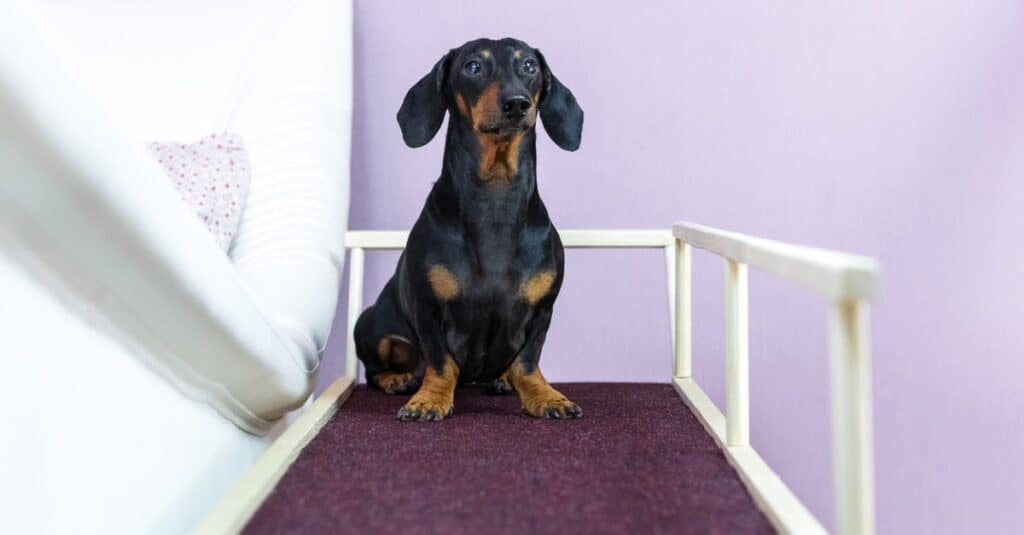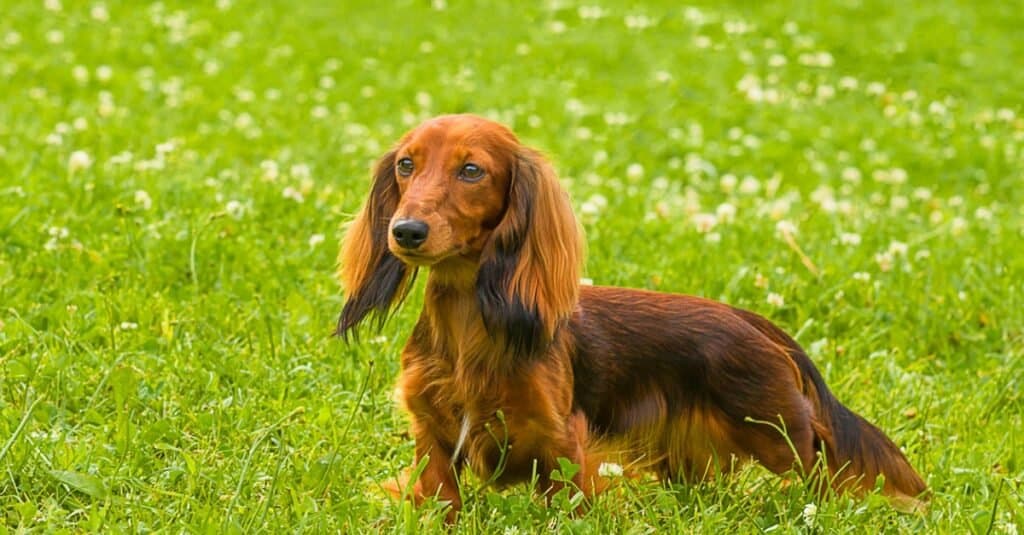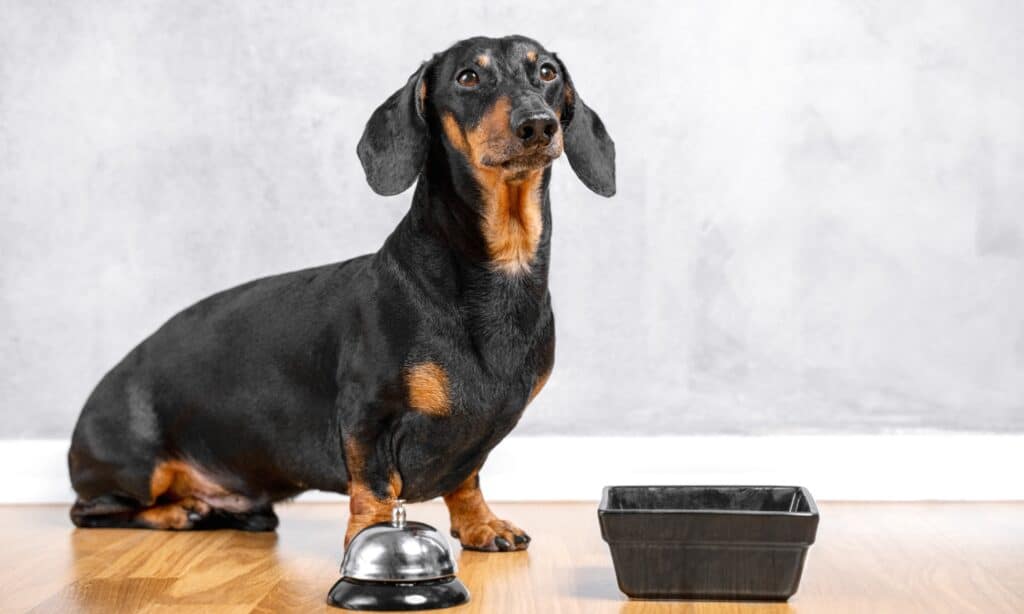Dachshunds are one of the first breeds we learn about as children. If you’re like me, you immediately fell in love with these short-legged hounds. But before you adopt one, you might wonder how much Dachshunds shed.
Dachshunds have three coat types, all of which shed moderately. Long-haired Dachshunds seem to shed the most, while wire-haired Dachshunds require the most upkeep. Smooth-coated Dachshunds are the easiest to maintain and lowest shedding.
No Dachshund is hypoallergenic as they aren’t low-shedding dogs, and they have fur rather than human-like hair.
In this article, we’ll talk about all three Doxie coat types, how much they shed, and how to care for each of these very different coats. Keep reading to learn more!
Dachshund Coat Characteristics

Masarik/Shutterstock.com
There are three types of Dachshund: smooth-coated, long-haired, and wire-haired.
Smooth-coated Dachshunds are short-haired with smooth fur. Long-haired Dachshunds have long, soft, sometimes curly fur.
Lastly, wire-haired Dachshunds have short fur throughout most of the body with longer hair on the face. Their coat’s texture is rougher than the other coat types.
Each fur type has its own characteristics, which we’ll explore further below.
Are Dachshunds Hypoallergenic?
Dachshunds are not hypoallergenic dogs. They shed moderately and have fur, while most hypoallergenic breeds shed very little and have more human-like hair.
They also often have double coats, which is uncommon in hypoallergenic breeds since these dogs tend to shed more than those with a single coat.
If you have dog allergies and want a Dachshund, I recommend spending time around the one you’d like to adopt. This can help you determine whether this specific dog sets off your allergies and if you can handle the symptoms.
Do Dachshunds Shed Seasonally?
Dachshunds shed year-round, but they also have shedding seasons where they shed more profusely. In the spring and fall, your Dachshund’s undercoat will fall out as it restructures itself for the upcoming season.
Double coats are amazing for dogs—they keep them cool in the summer and warm in the winter. This is part of the reason you should never shave a double-coated Dachshund, because it can affect their ability to maintain their body temperature.
During shedding season, grooming your Dachshund more often will help to reduce shed fur around your home and to keep your pup’s coat healthy. In long-haired and wire-haired Doxies, it’ll keep the fur from tangling and forming painful mats.
What Type of Dachshund Sheds the Least?

iStock.com/vizland
All types of Dachshunds shed moderately, but longhairs tend to shed the most. Wirehaired Dachshunds and those with double coats shed seasonally, while single-coated Dachshunds shed the same year-round.
All wire-haired Dachshunds have double coats, while some smooth-haired and long-haired Dachshunds have single coats. It depends on how they’re bred!
Do Dachshunds Smell?
All dogs have a distinct odor that’s unique to their species. Some people love it, and some people hate it. (I, personally, am the weirdo who even likes the smell of a wet dog!)
You’ll notice this odor more when your Dachshund is wet or has just been outside. However, they aren’t stinkier than any other breed.
If your Dachshund smells, this can indicate poor hygiene or a health problem. First, see where the scent is coming from. Do they have bad breath? A general odor? A sweet smell around their ears?
If the smell comes from your pup’s body, give them a bath! This should resolve the smell unless it’s due to a health problem, such as a skin infection.
Stinky breath may mean it’s time for a dental cleaning at the veterinarian. They might also advise you to brush your dog’s teeth more regularly, which we’ll discuss below.
An odor in the ears usually indicates an ear infection but can also be caused by injury or ear mites.
How to Groom a Dachshund

iStock.com/Ирина Мещерякова
Here are the steps to grooming your Dachshund from start to finish:
- Brush their coat as needed for their fur type
- Bathe them only as necessary
- Trim their nails monthly
- Clean their ears monthly
- Brush their teeth weekly or as often as possible
Hand-Strip Your Wirehaired Dachshund
Wire-haired Dachshunds need their fur hand-stripped several times a year. This involves pulling the loose undercoat out by the root, which surprisingly isn’t painful when done correctly!
I advise learning from a groomer if you’d like to do this yourself. Otherwise, bringing your Dachshund to the groomer to have them hand-stripped is best.
Brush your Dachshund According to Fur Type
Smooth-coated Doxies rarely need to be brushed, while long-haired pups require the most grooming. Here’s how to groom each fur type:
- Smooth-haired Dachshunds: Brush them as needed with a hound glove. This should be quick and must be done only once a week.
- Long-haired Dachshunds: Comb coat down to the skin once every few days. This is vital to prevent painful mats from forming in the fur.
- Wire-haired Dachshunds: Brush them one to two times a week using a brush for short-haired dogs on most of the body and a comb on their longer fur.
While brushing your Dachshund, check over its coat and skin for any abnormalities. This might include oily coats, dandruff, skin redness, inflammation, injury, or pests.
Bathe them As-Needed
Dachshunds are known as a clean breed, so they don’t tend to need frequent baths. Bathe them as needed with dog shampoo.
Wet the coat thoroughly down to the skin, then lather your dog shampoo of choice through the fur. Rinse well, making sure you remove all soap suds to prevent skin irritation.
Pay extra attention to their feet and, if you have a wire-haired Doxie, their longer fur. Check your pup’s bottom to ensure no feces or other debris is stuck in the coat, which is most common in long-haired dogs.
If you’d like, follow up with some coconut oil or dog conditioner.
Products made for humans can dry out or irritate your Dachshund’s skin, so I recommend avoiding them.
Trim your Doxie’s Nails Monthly
At least once a month, your Dachshund will need its nails trimmed. This will prevent injuries from the nails growing into the foot pads, breaking unevenly, or snagging on objects.
Many Dachshunds have all-black nails, so it’s important to familiarize yourself with dog claws before cutting them. All dog nails have a spot called the quick, located at the base of the paw and filled with blood. This hurts and bleeds when cut into.
In white nails, it’s easy to see the quick—but on black nails, it’s impossible. Trim only the sharp ends of the claw at first, slowly trimming more off as needed.
You can also invest in a dog nail dremel or train them to use a scratching pad to file their nails down. These have a lower risk of injuring your Doxie’s claws.
Here are some other nail-trimming tips:
- Always use a clean, sharp pair of nail clippers. Dull ones can splinter the nail, injuring your pup even without cutting the quick directly.
- Take training slowly. Get your pup used to having its paws handled while you pet them first. Then, move on to desensitizing them to the nail clippers. This patient training will pay off greatly for the rest of your Dachshund’s life!
- Apply flour or cornstarch to stop a bleeding nail. Accidents happen, and the bleeding will usually stop within a few minutes. See a veterinarian if it doesn’t; the injury might be serious.
- Check your Dachshund’s paws during nail trims. Look for dryness, splinters, or debris caught on the fur between the toes. You might also choose to clip this fur, wash your Doxie’s feet, or apply coconut oil to dry paw pads.
- If you’re struggling, bring your dog to the vet or groomer. They can trim the nails for you! The important thing is that it gets done, and there’s no shame if you need help.
Clean the Ears Once a Month
An often-overlooked grooming task is cleaning your dog’s ears. But Dachshunds can be prone to ear infections, so it’s important to keep up with their floppy ears.
Luckily, it’s very simple and only takes a few minutes. Your pup will likely love the experience as well—it feels like the best ear rub ever!
Here’s how to clean your Dachshund’s ears:
- Choose your supplies. Your cleaning tool can be a paper towel, q-tip, cotton ball, or cotton pad. Your cleaning solution can be an ear cleaner made for dogs or a small amount of baby oil.
- Flip the ear onto the head. This allows you to see the inside easily.
- Apply the cleaning solution to your tool of choice and gently use it to remove debris from the outer ear. Never stick anything into your dog’s ear canal, as this can injure its eardrum. You also risk pushing the ear wax inside until it becomes tightly compacted.
When cleaning your Dachshund’s ears, you can also check them for any redness, swelling, abnormal discharge, or odor. These can be symptoms of ear mites, an ear infection, or another health problem.
Brush the Teeth at Least Once Weekly
Speaking of overlooked grooming tasks: Brushing our dog’s teeth is one of the best things we can do for their health. It can also help to prevent that awful dog breath!
Dachshunds are small dogs, so they’re especially prone to dental problems. Brushing their teeth at home, as well as a yearly professional cleaning, can prevent costly dental surgeries later in their life.
You can also get a good idea of what your pup’s teeth and gums look like normally, so you’ll be better able to spot problems if they do arise.
Here’s how to clean your Dachshund’s teeth:
- Begin to handle their mouth regularly. Getting your Dachshund used to handling is super important! Remember to treat them for good behavior.
- Buy a dog toothpaste and toothbrush. Any toothbrush will work, but never use human toothpaste for your dog! It isn’t meant to be swallowed and can poison your pup.
- Let your Dachshund explore. They can sniff the toothbrush, taste the toothpaste, and eventually, you can begin touching it to their mouth. Again, reward good behavior and any positive interactions!
- Gently brush your dog’s teeth. Even if you can’t do a very thorough job at first, even brushing a few teeth at a time is a success! Keep training, and you and your Dachshund will get better in time.
Up Next:
- Dachshund vs. Doxin: Is There a Difference?
- Standard Dachshund vs. Miniature Dachshund: 5 Differences
- Dachshund Lifespan: How Long do Dachshunds Live?
- 10 Incredible Dachshund Facts
The post Do Dachshunds Shed? appeared first on AZ Animals.
from Animal News, Facts, Rankings, and More! - AZ Animals https://ift.tt/E0HKNGe